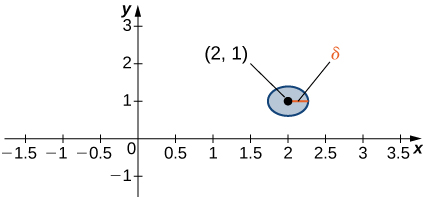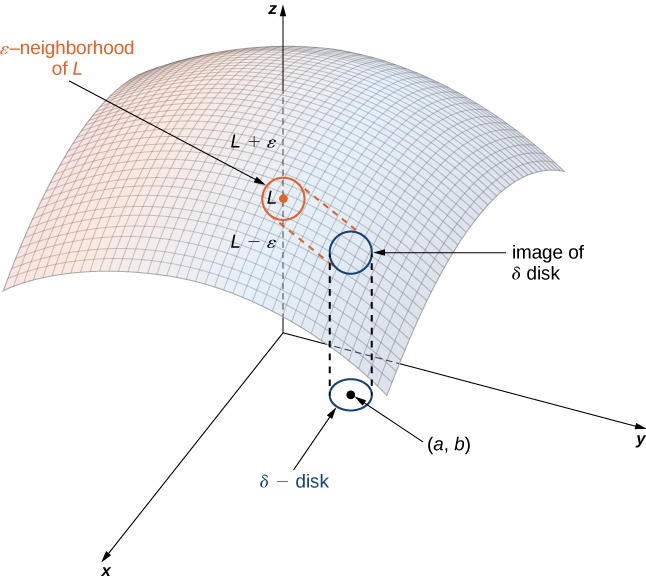| << Chapter < Page | Chapter >> Page > |
We have now examined functions of more than one variable and seen how to graph them. In this section, we see how to take the limit of a function of more than one variable, and what it means for a function of more than one variable to be continuous at a point in its domain. It turns out these concepts have aspects that just don’t occur with functions of one variable.
Recall from Section the definition of a limit of a function of one variable:
Let be defined for all in an open interval containing Let be a real number. Then
if for every there exists a such that if for all in the domain of then
Before we can adapt this definition to define a limit of a function of two variables, we first need to see how to extend the idea of an open interval in one variable to an open interval in two variables.
Consider a point A disk centered at point is defined to be an open disk of radius centered at point —that is,
as shown in the following graph.

The idea of a disk appears in the definition of the limit of a function of two variables. If is small, then all the points in the disk are close to This is completely analogous to being close to in the definition of a limit of a function of one variable. In one dimension, we express this restriction as
In more than one dimension, we use a disk.
Let be a function of two variables, and The limit of as approaches is written
if for each there exists a small enough such that for all points in a disk around except possibly for itself, the value of is no more than away from ( [link] ). Using symbols, we write the following: For any there exists a number such that

Proving that a limit exists using the definition of a limit of a function of two variables can be challenging. Instead, we use the following theorem, which gives us shortcuts to finding limits. The formulas in this theorem are an extension of the formulas in the limit laws theorem in The Limit Laws .
Let and be defined for all in a neighborhood around and assume the neighborhood is contained completely inside the domain of Assume that and are real numbers such that and and let be a constant. Then each of the following statements holds:
Constant Law:
Identity Laws:
Sum Law:
Difference Law:
Constant Multiple Law:
Product Law:
Quotient Law:
Power Law:
for any positive integer
Root Law:
for all if is odd and positive, and for if is even and positive.

Notification Switch
Would you like to follow the 'Calculus volume 3' conversation and receive update notifications?